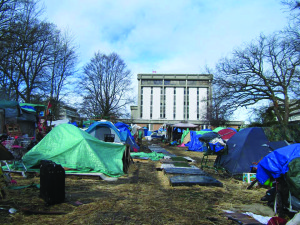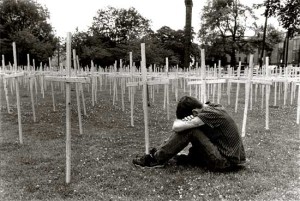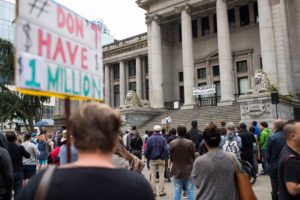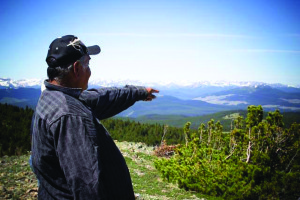
Being the thinking point between experience and action – Social movement journalism in 2016, a Volcano year in review
Articles published in The Volcano this year sketch a map of the difficulties that our social movements – particularly the anti-displacement and anti-dispossession movements where our editors are directly involved – have faced. These articles were mostly written out of a feeling of urgent need. We wrote articles because we needed to expose the attacks we were under and decry those attacking our communities. We wrote because we needed to tell the stories of our struggles to resist oppression and survive. We wrote because we needed to argue against lying politicians and bigots who dehumanize the people most vulnerable to violence. But looking back, it is clear that our publishing efforts also fulfill a need to record, remember, and archive our histories. This archive of articles provides us with a collective memory, and lessons from our yesterdays that can help us with our tomorrows.
This year The Volcano published 3 print newspapers, 1 special issue, and 25 newsletters – which we founded in June and have published every week since. All together these publications collect more than 200 articles. Although these 200 articles cover a vast array of themes and issues, there are a few themes that emerge as indicative of life in 2016 in southern British Columbia. The social movement journalism of The Volcano has helped highlight, theorize, and nudge these themes into discussions and knowledge in our communities.
 Theme #1 – Tent cities as low-income community organization
Theme #1 – Tent cities as low-income community organization
Housing justice movements have often hesitated to embrace tent cities as much more than symbolic protest sites. They have been useful to draw attention to homelessness and raise political demands. But more recently tent cities in British Columbia emerged as spaces where homeless survival techniques of camping in small groups for safety and security transformed into collective resistance.
Dignity Village tent cities in Abbotsford, Oppenheimer and 58 tent cities in the Downtown Eastside, Cliff Avenue tent city in Maple Ridge, the tent city in Langley, Super InTent City in Victoria, and the 135A Strip in Surrey all demonstrate what The Volcano referred to as the “enlarged citizenship” of low-income community power. Not only did these tent cities pressure governments to build new housing and courts to overturn some anti-poor laws, they facilitated caring relationships between homeless people that functioned outside of capitalist markets and autonomous of police and medical institutions.
Rather than protest or appeals to public awareness, it seems to have been the emergent independent power of these spaces, the potential for homeless people to break from dominant state and society that has forced governments to provide housing resources to break up tent cities. The Volcano has played an important role in theorizing and developing these political perspectives, as well as critiquing the socially regulatory and controlling shelters, hospitals, supportive housing, and prisons that tent city residents are shoveled into.
 Theme #2 – Overdose crisis provokes a new call to end the war on drugs
Theme #2 – Overdose crisis provokes a new call to end the war on drugs
As the opioid overdose crisis has become an undeniable catastrophe, it has finally entered public discourse. The government held a conference in Ottawa and there are regular columns in mainstream media. But the chorus remains fixated on prevention and treatment as the only thinkable responses to the horrific numbers of deaths.
The Volcano has pushed for the decriminalization of drugs, to take the deadly substances out of the anarchic underground, unregulated marketplace, as the only practical way to end the overdose epidemic today. This year we have celebrated first responders, reflected on addiction as a crisis of social (not individual) health, critiqued the state’s limited, punitive efforts to stop overdoses, and pushed relentlessly to end drug prohibition. The fact that mass deaths are a theme of 2016 is heartbreaking, and perhaps the only bright spot is that the solution is more in sight than ever before.
 Theme #3 – The housing market is our problem, not our solution
Theme #3 – The housing market is our problem, not our solution
2016 was a paradox of homelessness in Vancouver. On the one hand, it was the year with the highest homeless count in history. And on the other it was the year that the government, all political parties, and the media dismissed homelessness as yesterday’s news and began instead to focus on the “housing crisis” for the professional-managerial class who felt disappointed that they cannot afford to buy detached homes. While record numbers of people slept on the (increasingly frozen) streets, the “foreign investment crisis” subsumed headlines, BC Liberal housing policy reforms, and even the BC NDP housing critic’s portfolio.
The Volcano was the only publication to consistently and persistently push back against this diversion. We fought against the foreign investment myth, and published an entire newsletter dedicated to the speeches of community activists dissecting the racist, settler, imperialist discourse. We exposed the misnomers that the Trudeau government was creating a national social housing plan, that the housing ownership market could offer anything to working class people, that the protests for controls over foreign investment were part of our movements, and that the BC Liberal pre-election housing announcements would even put a dent in the homelessness crisis. And we called over and over and over again for tax-funded social housing, not foundation charity, not shelters, not rent supplements to landlords, not demovictions for condo towers, and not “innovative” market tricks.

Theme #4 – The relationships between (capitalist) displacement and (colonial) dispossession
While others have noticed the significance of Indigenous resurgence in 2016, The Volcano has focused on the tensions of Indigenous-led movements against colonial dispossession (particularly in the forms of resource extraction) with movements against the displacement of low-income communities. Forces of displacement disproportionately impact Indigenous people, so lines of commonality could be easily drawn by saying both forces impact the same communities. But can we square the circle of urban-based, multi-racial movements demanding the Canadian state redistribute wealth downwards when all that wealth is stolen through dispossession?
We have grappled with this tension by supporting the Alliance Against Displacement six-class discussion series on the question, and by placing coverage of anti-displacement struggles alongside Indigenous struggles against the Kinder Morgan pipeline, Dakota Access Pipeline, the Petronas LNG plant, foster care apprehensions, and for traditional birthing practices. Publishing news of these struggles on the page together has led to debates in tent cities about who pipeline development really supports, who it hurts, and what the connections between extraction and homelessness are in everyday life.
The thinking point and social movement journalism
These four themes found expression in the pages of The Volcano in a way that is unusual in journalism today. The Volcano writers and editors become aware of political problems first as problems of community experience – either because those we organize with directly experience a harm (like someone who is homeless has their tent slashed by a bylaw officer) or because those harms are so well rehearsed that they have become knowledge in our group, and therefore we can anticipate the effect of a new state or corporate initiative (like when the BC Government announces a turn from building social housing to increasing private subsidies to landlords).
This year, as we began publishing more regularly with a weekly newsletter, we found our journalism began operating as part of a thinking point in between bodies that experience harms and bodies that take action against those harms. Being this thinking point is a good way to define social movement journalism.
This year we have not resolved these four themes outlined above. This is because these are complicated questions that can only be answered by the collective activity of vast communities of people. To reach enough people for the action to be effective, the thinking point can take a long time. And that’s a challenge for the year ahead.
